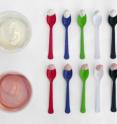Cutlery: Do size, weight, shape and color matter?
The appearance of cutlery can affect perception of a food's taste, reports BioMed Central's open access journal Flavour. Food tastes saltier when eaten from a knife, and denser and more expensive from a light plastic spoon. Taste was also affected by the color of the cutlery. The crockery we use has been shown to alter our perception of food and drink. Beverages in cold colored glasses were rated more refreshing and the weight and color of a plate can alter how dense, salty or sweet food tastes. In this study, researchers from the University of Oxford demonstrated that cutlery can also have an impact on how we experience food.
They found that when the weight of the cutlery confirms expectations (e.g. a plastic spoon is light), yoghurt seemed denser and more expensive. Color contrast is also an important factor: white yoghurt when eaten from a white spoon was rated sweeter, more liked, and more expensive than pink-colored yoghurt. These effects were reversed for yoghurt tasted from a black spoon, which suggests that color contrast mediates the effects of cutlery on flavor perception. Similarly, when offered cheese on a knife, spoon, fork or toothpick, the cheese from a knife tasted saltiest.
Dr Vanessa Harrar and Prof Charles Spence, who performed this study, explain, "How we experience food is a multisensory experience involving taste, feel of the food in our mouths, aroma, and the feasting of our eyes. Even before we put food into our mouths our brains have made a judgment about it, which affects our overall experience."
Vanessa Harrar continued, "Subtly changing eating implements and tableware can affect how pleasurable, or filling, food appears. So, when serving a dish, one should keep in mind that the color of the food appears different depending on the background on which it is presented (plate or cutlery) and, therefore, tastes different. This may also be used to help control eating patterns such as portion size or how much salt is added to food. Alternatively, people may be able to make better food choices if their ingrained color associations are disrupted by less constant advertising and packaging."
Source: BioMed Central Limited
Other sources
- Study: Choosing knife, fork or spoon can affect how food tastesfrom UPIWed, 26 Jun 2013, 21:00:14 UTC
- Cutlery: Do size, weight, shape and color matter?from Science DailyWed, 26 Jun 2013, 19:00:26 UTC
- Colour-coded cutlery and the science of taste | Amy Flemingfrom The Guardian - ScienceWed, 26 Jun 2013, 17:30:36 UTC
- Cutlery 'can influence food taste'from BBC News: Science & NatureWed, 26 Jun 2013, 8:00:52 UTC
- To Cut Out Salt, Use a Knifefrom Live ScienceWed, 26 Jun 2013, 1:00:29 UTC
- ScienceShot: Unexpected Cutlery Makes Food Taste Badfrom Science NOWWed, 26 Jun 2013, 0:20:09 UTC
